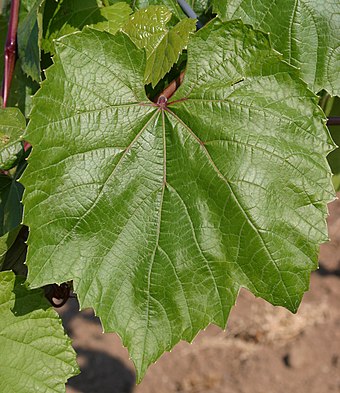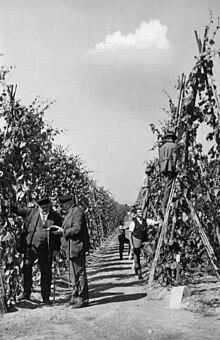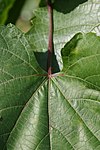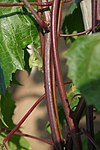Kober 5 BB
| Kober 5 BB | |
|---|---|
| Synonyms | see section synonyms |
| Breeding number | 5 BB |

|
|
| use | |
| origin | Austria |
| known since | 1920 |
| breeder | Selection by Sigmund Teleki (Teleki 5 A) in Villány and selection by Franz Kober in Klosterneuburg |
| Launch | 1920 |
| VIVC no. | 6313 |
| ancestry | |
| List of grape varieties | |
The Kober 5 BB is a hybrid vine , by the intersection of Euvitis - species Vitis riparia and Vitis berlandieri has arisen and as rootstocks places for biotechnical fighting the root phylloxera for phylloxera-susceptible varieties ( Vitis vinifera is used). It is one of the first documents to achieve worldwide importance.
origin
In 1896, the Hungarian winery owner Sigmund Teleki in Villány obtained 22 pounds of wild grape seeds from the lime vine ( Vitis berlandieri ) from the French vine grower Euryale Rességuier. Because of the special quarantine regulations at the time, traffic with green or woody parts of the vine was prohibited due to the possibility of the further spread of phylloxera ( Viteus vitifoliae ), so Teleki obtained grape seeds. He planted about 40,000 seedlings, resulting in different populations that were both pure Berlandieri types, Berlandieri × Riparia and Berlandieri × Rupestris types.
In 1904, Franz Kober commissioned Sigmund Teleki to send him shoots from a whole hive of each distinct type of the Berlandieri × Riparia selections. Kober planted the vines in a piece of land leased by the Ministry of Agriculture on the Nussberg in Vienna .
During his selection work, Franz Kober made about 50 different types in four different groups with the letters A, B, C and D:
- A: Plants with a bronzed tip and with reddish and hairy shoots.
- B: Plants with bronzed shoot tips, with reddish and smooth shoots.
- C: Plants with green shoot tips, with green shoots that are slightly reddish and hairy on the sun-facing side.
- D: Plants with green shoot tips, green, smooth shoots and reddish-colored nodes.
From around 100 plants, Kober selected the particularly robust and vigorous ones, which he marked with a double letter following the selection number (e.g. 5 BB). During the selection, the 5th floor of the type he called BB turned out to be the best for Austrian location conditions. He had this stock propagated in the municipal nursery school in Wiener Neustadt and in 1920, when there were already several Katastraljoch 5-BB cut vineyards in production, he presented these vines to the public.
It was thanks to Franz Kober that he quickly spread this valuable rootstock. He has kept Teleki's origins a secret. He called it the Kober vine, although the basic selection was made by Teleki. According to Andor Teleki, it is identical to the Teleki 5 A. The only difference in the dispute should be that, according to Kober, 5 BB only increased from one stick, while Teleki initially increased the Teleki 5 A from three identical sticks. In all probability, however, the three sticks came from a common mother stick.
In their work, both Teleki and Kober made the mistake of having mixed very similar types with the same number designation on the market. A number of selections were soon made from this Kober 5 BB type mixture in the wine-growing countries. Ferdinand Reckendorfer (Director of the Krems Wine School ) selected the R 7, R 27, R 43 and the 8-35 from the Kober 5 BB. Carl Börner (director of the Biological Reichsanstalt in Naumburg an der Saale ) selected the 59 B, 64 B and 68 B. These selections were irrelevant.
Today, different clones of the Kober 5 BB, which have gone through a phytosanitary control, are available in the countries .
ancestry
5BB is a hybrid vine from Vitis riparia × Vitis berlandieri selection by Sigmund Teleki (Teleki 5 A) in Villány and selection by Franz Kober in Klosterneuburg ( Lower Austria ), who brought it to the market in 1920 as Kober 5 BB.
Ampelographic features
- Shoot tip: is half-open to open, reddish-brown-green to bronzed with a weak white woolen coating, with carmine-red edges.
- Young leaves: are hairy like a cobweb, copper-colored, with a broad central lobe.
- Adult leaf: The leaf is large and undivided. The upper side of the leaf is shiny and the leaf veins bristly underneath, lightly woolly hairy and often provided with small tufts of bristles in the nerve corners. The leaf margin is serrated wide. The stem bay is U-shaped.
- Tendrils: are simply forked.
- Blossom: The inflorescences are small. Depending on the selection, there are 5 BB with male or female pseudo-hermaphroditic flowers. The clone selected by Weiß - from selection material which can be proven to come from the original Franz Kober vine - has male pseudo-hermaphroditic flowers. In the selections in Germany, the flowers are covered with female pseudo-hermaphroditic flowers.
- Grapes: In the female flowering selections, the grapes are small with round, black berries.
- Annual wood: The annual wood is slightly hairy at the nodes, finely ribbed, beige with darker nodes.
properties
The resistance of the Kober 5 BB to phylloxera root lice is good. It is highly susceptible to leaf aphid, but this does not play a role as a rootstock, but only in the propagation of the rootstock. The variety brings good growth yields in the nursery when propagated. It makes little demands on the soil and has good limescale tolerance and also tolerates drought well. It has a large floor adaptation width. Because of these properties, it is also known as a universal rootstock. It tolerates up to 20% free lime (activated lime) in the soil and is particularly suitable for well-drained, lighter soils.
For red wine varieties, stem paralyzes and berry botrytis can be promoted. The rootstock has strong growth, which also leads to stronger growth in the refined noble varieties. Larger space is required for the vine, especially on very vigorous soil locations. Grafted noble varieties that are sensitive to blossoms (such as: Riesling , Neuburger ) may lead to less fruit set due to increased flowering of the blossoms. Waterlogging causes chlorotic leaf symptoms in the noble variety.
Synonyms
- Kober 5 BB in the database Vitis International Variety Catalog of the Institute for Grapevine Breeding Geilweilerhof (English)
Web links
- Kober 5 BB in the database Vitis International Variety Catalog of the Institute for Grapevine Breeding Geilweilerhof (English)
- Geisenheim University, Institute for Vine Breeding
- Geisenheim University, Institute for Vine Breeding, Kober 5 BB (PDF; 144 kB)
- 5 BB Klon Wü 137 Bavarian State Institute for Viticulture and Horticulture Würzburg
- Kober 5 BB, catalog for grape varieties and documents, English / French.
- Volker Jörger, Grape Breeding - Selected Results of the Freiburg Breeding Work, Freiburg State Viticulture Institute, December 21, 2010 PP pdf .
literature
- Karl Bauer, Ferdinand Regner , Barbara Schildberger: Viticulture (= AV book. ). 9th, updated edition. Cadmos, Vienna 2013, ISBN 978-3-7040-2284-4 .
- Erwin Kadisch (founder): Viticulture (= the winemaker. Vol. 1). Edited by Edgar Müller. 3rd, completely revised edition. Eugen Ulmer, 2008, ISBN 978-3-8001-1241-8 .
- Karl Müller (Ed.): Viticulture Lexicon. For winemakers, wine merchants, coopers and innkeepers. Paul Parey publishing house, Berlin 1930.
- Jancis Robinson : The Oxford Wine Lexicon. 3rd, completely revised edition. Hallwag, Munich 2007, ISBN 978-3-8338-0691-9 .
- Joachim Schmid, Frank Manty, Bettina Lindner: Geisenheimer grape varieties and clones (= Geisenheimer reports. 67). Geisenheim Research Institute - Department of Vine Breeding and Refinement, Geisenheim 2009, ISBN 978-3-934742-56-7 .
Individual evidence
- ^ Karl Bauer, Ferdinand Regner, Barbara Schildberger: Viticulture. 9th, updated edition. 2013, p. 116.
- ↑ Hans Ambrosi , Bernd HE Hill, Erika Maul, Ernst H. Rühl, Joachim Schmid, Fritz Schumann: color atlas grape varieties. 300 varieties and their wines. 3rd, completely revised edition. Eugen Ulmer, Stuttgart 2011, ISBN 978-3-8001-5957-4 , p. 484.
- ^ Karl Müller: Viticulture Lexicon. 1930, p. 428.
- ^ Andor Teleki: Modern viticulture. The reconstruction of the vineyards. 3rd, completely revised and significantly expanded edition. A. Hartleben, Vienna a. a. 1927, pp. 94-101.
- ^ Andor Teleki: Modern viticulture. The reconstruction of the vineyards. 3rd, completely revised and significantly expanded edition. A. Hartleben, Vienna a. a. 1927, p. 99.
- ↑ John White, Christian Jaborek: rootstocks, yesterday - today - tomorrow. 5 BB - 5 C - R 27 - clones of Austrian origin. Österreichischer Agrarverlag, Vienna 1990.
- ↑ Joachim Schmid, Frank Manty, Bettina Lindner: Geisenheimer grape varieties and clones. 2009, p. 127.
- ^ DP Pongrácz: Rootstock for Grape-vines. David Philip Publisher, Cape Town a. a. 1983, ISBN 0-908396-67-8 , pp. 58-59, p. 102.






